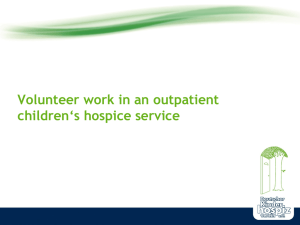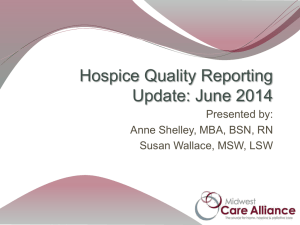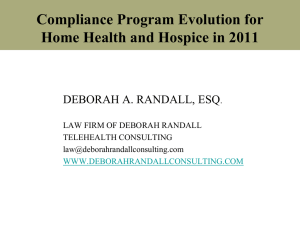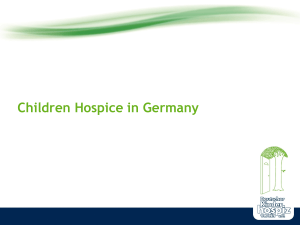Under the OIG Microscope - Deborah Randall Consulting
advertisement
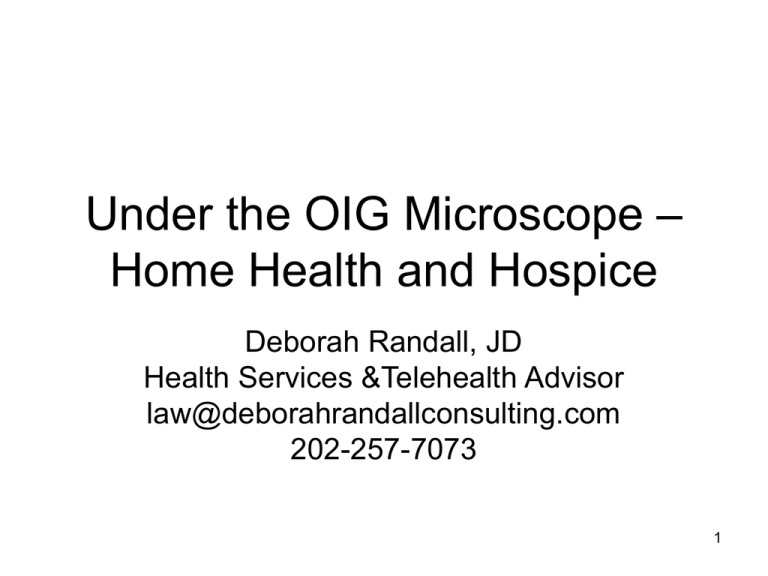
Under the OIG Microscope – Home Health and Hospice Deborah Randall, JD Health Services &Telehealth Advisor law@deborahrandallconsulting.com 202-257-7073 1 Why the Increased Scrutiny • History – Operation Restore Trust in the 1990’s affecting Home Health Medicare • Change of reimbursement for Home Health in 2000 to PPS [prospective payment system], some years after hospital DRGs and nursing home PPS • Movement under President Bush to patient centered care – ‘Money Follows the Person’ 2 History and Scrutiny • Addition of Patient-controlled personal care under the Medicaid optional benefit • ‘Nursing Home without Walls’ approach to de-institutionalizing chronic care, and Olmstead decision underscoring patient’s right to least restrictive environment for care • Limited budgets for State Agency surveys 3 History and Scrutiny • Surge of new Home Health Agencies after end to certificate of need in many states • State Medicaid program inconsistency in oversight of Medicaid programs plus lack of administrative funds devoted to fraud reviews • Cyclical fraud issue in DME area and rise of power wheelchair vehicle scandals – common issue of unobserved relationship between supplier/provider and vulnerable elder at home 4 History and Scrutiny • Hospice as small, underutilized service • Traditions and ‘core services’ concepts • Coverage by episode of care with capitated reimbursement in the aggregate BUT daily reimbursement; no co-pay • Positive promotion of end of life care and changes in physician attitudes 5 History and Scrutiny • Regulatory requirement for Medical Director role in Hospice with little description of who and how role is played • ? Other possible changes in hospice service environment stemming from changes in physician, nursing facility, home health and assisted living areas 6 Compliance Officers’ attention to OIG Annual Work Plans • Compliance planning includes review of laws, regulations, and interpretations such as OIG advisory opinions even though these are provider-specific • OIG signals directions and concerns through testimony before Congress, Reports and OEI recommendations, and the Annual Work Plan which is public 7 OIG Work Plan Structure • Work Plan is structured both across payment areas –Medicare and Medicaid— and across industries • Compliance officers, advisors and attorneys need understanding of the mechanisms of the industries to identify concerns, audit targets and training and teaching requirements 8 Provider Structure • Medicare home health agencies [HHAs] must be certified, 42 CFR 484; Medicaid home health care must be delivered by certified HHAs except for certain waivered Home and CommunityBased services [HCBS]; Hospices must be certified, 42 CFR 418, for Medicare/Medicaid $ • Hospices, HHAs and HCBS agencies may be for profit/non profit; independent or hospital/SNF based; private, publicly traded or governmentally owned 9 Site of Care • HHA services are in any ‘home’, including an assisted-living residence, but not in a ‘nursing facility’ or hospital. HCBS sometimes have a broader site of care. Private duty nursing services may supplement institutional care, depending on the State Plan. • Hospice services are ‘routine homecare’ or ‘continuous care’ in a residence including a nonSNF; ‘in-patient care’ in a hospital/SNF; or ‘respite’ in a SNF or hospital [w reduced nursing] 10 Miscoded HHA Casemix • OIG checking if payment codes [HHRGs] are accurate. These derive from the assessments done on the ‘OASIS’ tool by the providers. • Four levels of payment; intensity of therapy and care needs, diagnoses and prior hospitalizations drive levels. One level looks at total visits < 4 [LUPA]. 11 Concern about OASIS accuracy • CMS has not probed OASIS accuracy; and submissions are indirect, through the State Agency • OASIS C now linking to quality of care, value based purchasing as goal, and National Quality Forum recommendations • Pressures on HHA staff from several directions 12 High Outlier HHAs • Massive statistical issue with Florida HHAs • Change in 2010 PPS rule [maybe statute] to cap each HHA outlier at not more than 10% • Same Underlying Concerns Linked to = DIABETES INJECTION VISITS DIABETES SELF-MANAGEMENT PROGRAMS - GEOGRAPHICS 13 Utilization and Profitability • OIG concerned about growth in HHA payments, blatant false billing rackets • MedPac taking the lead in suggesting profitability levels suggest overpayment • Congress- Senate Healthcare reform bill is clipping the market basket and updates to => 42% decrease in HHA payouts over ten years 14 Medicaid homecare and community-based services • States and CMS have been lax in monitoring homecare services, surveys, the entitlement of recipients, and the duplication with other paid services such as assisted living • Personal care services by uncredentialed workers is on the rise. Sometimes subcontracted to HHAs, sometimes direct to the home 15 Dual-eligible homecare patients • Patients may be eligible for different services, or staffing of services from Medicaid and Medicare in both homecare and hospice. • Medicaid as payer of last resort • Failure to properly identify billing situation could move from error to false claims situation, given the highlighting of this issue by state Inspector Generals 16 Compliance Officer Goals • Audit to the problematic growth trends • Monitor maintenance services to chronically ill patients • Ask about and participate in finance and marketing meetings of your HHA to measure if message is problematic • Work with clinical staff to prevent trend to a ‘perfect’ and expensive OASIS pressure 17 Hospice Physician Billing • OIG studying frequency and total expenditures for billed services under Part A and Part B Medicare 1. Does hospice have correct distinction for administrative physician services including service on the IDT, as medical director or consulting physician advising the hospice entity which are non-billable => Teachable moment; audit topic 18 Hospice Physician Billing 2. Does the hospice, not the physician, bill Part A for any medical service covered under the benefit & rendered by physicians with any relationship to the hospice. This includes volunteers who may also be the patient’s attending => Compliance documentation and control moment. Fraud and kickback potential for physicians who will receive 100% pass through from hospice, but 80% Part B if physician billed 19 Hospice Physician Billing 3. Is the physician service medically necessary for the hospice patient? Compliance concern = > are referring physicians who are also contracted to the hospice getting paid for more visits than the average patient whose physician does not have a relationship with the patient? RAC, ZPIC and MAC also are concerned about this. 20 Cahaba Hospice Guide 21 Billing error of physicians’ care of patients in hospice • Hospices must properly educate physicians that they cannot bill when the hospice is required to do the billing. Compliance hotspots => Is service related to the terminal illness; is the Part B billing for certification and recertification of a care plan, or is that absorbed into the work of the IDT; is the medical director referring to the hospice and is she/he in an administrative home visit. 22 Utilization trends • Since 1997 Balance Budget Act, a patient potentially could have numerous consecutive certification periods if terminal status is demonstrated and documented. • ‘Six month’ likely outside limit of continued life varies by illness, environment, age and numerous factors including stabilization and deterioration. You look forward from the moment you are assessing in the entitlement decision for coverage. 23 Utilization trends,cont. • Hospice fraud cases and settlements of False Claims cases have focused on 1.long duration cases; 2.non-cancer diagnoses especially Alzheimer’s,debility, Parkinson’s and ALS; 3. patients residing in nursing facilities and 4. the documentation which supports or not the reasonable determination of terminality. • Physicians [no NPs] re-certify but rely on the IDT and care-giving staff to keep the case open. 24 MedPac questions duration of hospice cases; OIG watching • Healthcare Reform may lead to an independent review panel with more authority even than MedPac is showing • OIG traditionally advocates to Congress for payment methodology changes when high growth rate plus examples of abuse suggest that broad-based approach. With HHAs, OIG pressed for PPS to replace fee for service. • Hospices are paid every day whether an active service is delivered or not; there is no co-pay 25 Duplicate billing of hospice drugs • Patients should not be submitting Part D reimbursement requests for any drug related to the terminal illness or palliation of that illness • Hospices should instruct their patients, the nursing facilities where patients reside, assisted living residences or other providers from which patients derive services. • NOTE- parallel to the NF not billing room and board when patient is Medicaid recipient and NF is paid over room and board by the hospice 26 The ‘missing’ Topic • In past, OIG signaled reviews of hospice patients in nursing facilities as high level of review • These concerns are now evidenced in nation-wide investigations of hospices concerning length of stay, questionable terminal status and relationships between hospices and long term care facilities 27 Compliance Officer Goals • Design and monitor training to physicians and hospice billing office • Watch for spiking trends of physician billing generally, and by practitioner • Discourage excessive use of ‘consultants’ • Underscore with Medical Director her/his role in supervision of physicians and administrative direction of the hospice 28 Compliance Officer Goals, 2 • Ensure the contracts between hospice and nursing facilities meet new requirements of the Conditions of Participation 42 CFR 418, in place since December 2008. • Audit the admission trends of the hospice, review the promotional materials and the budget, interview any liaisons placed in community facilities or sent to doctors’ offices • Train on the limitations of in-patient and continuous care as components of hospice care 29 Contact Info THANK YOU Deborah Randall, JD law@deborahrandallconsulting.com 30

